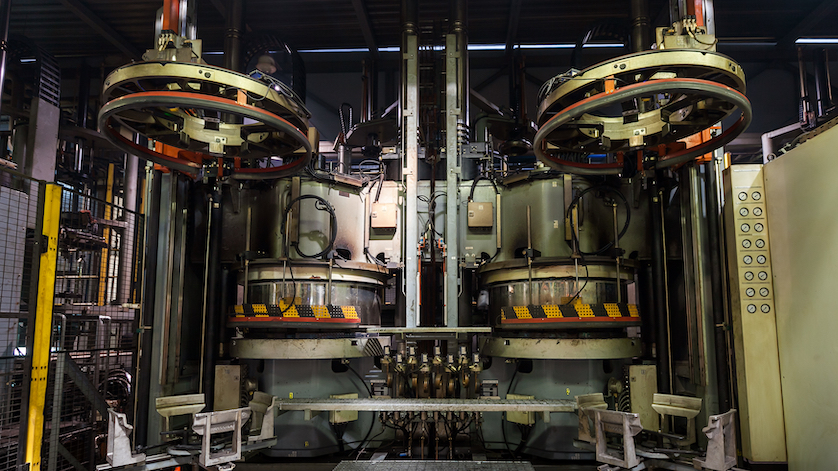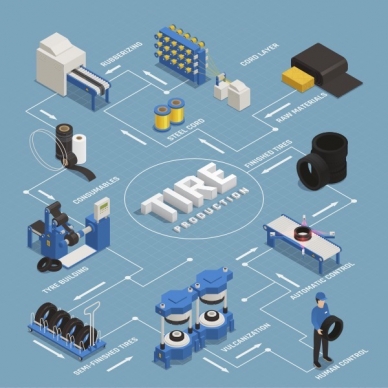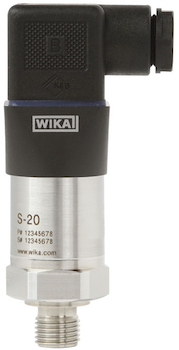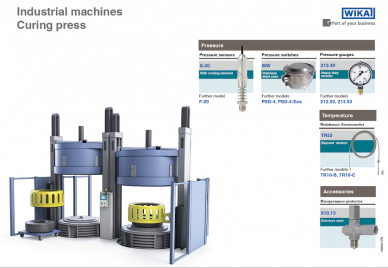
Tired of high maintenance costs due to measuring instrumentation failure during the curing process, a major tire manufacturer switched to WIKA’s S-20 heavy-duty industrial pressure transmitter for reliable performance and a significantly longer service life.
Automotive technology continues to evolve, with alternative fuels, advanced electronics, digital connectivity, and more. But one aspect remains fairly unchanged: the tires. The vast majority of today’s tires, no matter how basic or high performance they are, undergo vulcanization, or curing, to make them roadworthy.
Making and Curing Tires
Manufacturing the different components of a modern tire involves compounding, mixing, and kneading up to thirty raw materials: natural and synthetic rubbers, sulfur, steel, carbon black, fibers, and other additives. Once all the parts – belts, sidewalls, fillers, beads, etc. – are produced and built up, this “green tire” is put into a curing, or vulcanization, press.
The tire curing press is a round mold with a bladder in the center. Hot water or steam is pumped into this bladder, which expands and presses the raw tire against the sides of the hot mold. Under high pressure and temperature, the rubber compound vulcanizes into flexible, elastic rubber. The mold also gives the tire its final shape and sidewall markings.
The Role of Pressure and Temperature in a Tire Curing Press
Tire curing takes time, energy, and high pressure and temperature. Having the right pressure and temperature during the vulcanization process directly impacts the quality of the final product and the efficiency of the entire process.
Pressure measurement during vulcanization
The curing press’s bladder is under high pressure, up to 350 psi (24 bar), so that it can push the green tire against the mold’s walls. If the pressure is too low, the polymers will crosslink less, resulting in a less-rigid tire and, therefore, tires with lower mileage. Pressure that is too high results in unnecessary energy consumption at the plant and reduces the bladders lifespan, resulting in high maintenance costs and downtime.
Temperature measurement during vulcanization
Temperature affects the curing speed. The hotter the press, in the 340°F to 390°F (170°C to 200°C) range, the shorter the process and the sooner the next green tire can be processed. But if the temperature is too high, the rubber is damaged.
Problem: Failing Pressure Transmitters During Curing
A major tire manufacturer was having significant issues with the pressure transmitters in its curing presses. Namely, the sensors kept failing, leading to frequent downtime and extra costs. Not having success dealing with the original supplier, engineers at the tire company reached out to WIKA to help them figure out what was going on.
After looking at the manufacturer’s curing presses and the failed pressure transmitters, WIKA specialists discovered that there was nothing wrong with the equipment or the process. Their current sensors, however, were not robust enough to withstand the press’s challenging process conditions:
- Rapid pressure and temperature changes
- High temperatures
- Continuous pressure cycles
- Overpressure and vacuum pressure
- Corrosive sulfurous atmosphere
WIKA’s Heavy-Duty Solution for Extreme Conditions
The tire manufacturer needed to upgrade the pressure sensors used in its curing presses, and we recommended the S-20. It was specifically designed for critical applications in extreme environments, and is one of the toughest industrial pressure transmitters in the market today.
With a robust, all stainless steel design, the S-20 withstands vibration, shock, and aggressive media. This versatile sensor offers all the standard industry output signals, process and electrical connections, and measuring ranges up to 20,000 psi (1,600 bar) in all the major units, make it easy to integrate into almost any application. With a cooling element like the 910.32, this heavy-duty transmitter’s temperature range extends up to 392°F (200°C).
Besides the cooling element, we also suggested the 990.34 all-welded diaphragm seal to separate the transmitter from hot, corrosive, or clogging media. Also, adding the MW diaphragm pressure switch provides additional protection during the curing process by ensuring the safety interlock system does not prematurely open until a safe preset pressure is reached.
WIKA USA, Part of Your Tire Building Business
WIKA’s portfolio for machine building and automation includes high-quality, heavy-duty industrial pressure transmittersand pressure switches, protective devices, and resistance thermometers. We understand that it can be challenging to choose the right pressure and temperature solutions for your particular applications, so contact the industrial instrumentation specialists at WIKA USA for personalized recommendations.
Products mentioned in this blog:
• S-20 pressure transmitter
• 910.32 cooling element
• 990.34 diaphragm seal, welded design
• MW diaphragm pressure switch




